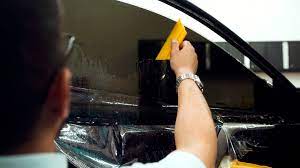Ee dhabta ah ee ka-hortagga baabuurta, https://windowtintingnewyorkcity.com window tinting stands out as a versatile and practical upgrade that enhances both the aesthetic appeal and functionality of a vehicle. Beyond merely adding a sleek look, window tinting offers a plethora of benefits ranging from protecting against UV radiation to improving privacy and safety on the road. This article delves into the world of window tinting, exploring its advantages, Noocyada, installation process, and regulations.
Understanding Window Tinting:
Window tinting involves applying a thin, transparent film to the interior surface of a vehicle’s windows. This film is composed of layers of polyester and other materials that are dyed or metalized to achieve the desired properties. It is designed to reduce the amount of visible light, infrared radiation, and ultraviolet (UV) rays that enter the vehicle.
Benefits of Window Tinting:
- UV Protection: One of the primary benefits of window tinting is its ability to block up to 99% of harmful UV rays. This protection helps prevent skin damage, premature aging, and even reduces the risk of skin cancer.
- Heat Reduction: By blocking infrared radiation, window tinting significantly reduces the heat buildup inside the vehicle, keeping it cooler and more comfortable, especially during hot summer days.
- Glare Reduction: Tinted windows minimize glare from the sun, headlights, and reflective surfaces, improving visibility and reducing eye strain for the driver and passengers.
- Enhanced Privacy: Tinted windows provide occupants with increased privacy by limiting the visibility into the vehicle from the outside, deterring potential theft and ensuring a more secure environment.
- Interior Protection: Window tinting helps protect the vehicle’s interior from fading, cracking, and discoloration caused by prolonged exposure to sunlight.
- Safety Improvement: In the event of an accident, window tinting can help hold shattered glass together, reducing the risk of injuries from flying shards and enhancing overall safety.
Types of Window Tinting:
There are several types of window tinting films available, each offering different levels of tint darkness and performance characteristics:
- Dyed Film: This type of tinting uses multiple layers of dye to absorb solar heat and reduce glare. It is an affordable option that provides good heat rejection and UV protection.
- Metalized Film: Metalized tinting incorporates metallic particles into the film, which reflect heat and UV rays. It offers excellent heat rejection and durability but may interfere with electronic devices’ signals.
- Carbon Film: Carbon tinting contains carbon particles that block infrared radiation without interfering with electronic signals. It provides superior heat rejection, UV protection, and a sleek, matte finish.
- Ceramic Film: Ceramic tinting utilizes nano-ceramic technology to provide the highest level of heat rejection, UV protection, and clarity. It is non-metallic, non-conductive, and does not interfere with electronic signals, making it the premium choice for window tinting.
Installation Process:
Window tinting should be performed by trained professionals to ensure a proper and flawless application. The process typically involves the following steps:
- Surface Preparation: The windows are thoroughly cleaned to remove any dirt, dust, and debris.
- Film Cutting: The tinting film is precisely cut according to the dimensions of each window using computerized cutting technology.
- Film Application: The tinting film is carefully applied to the interior surface of the windows, ensuring a smooth and bubble-free finish.
- Squeegeeing: Any air bubbles and excess moisture are removed from between the film and the glass using a squeegee.
- Drying and Curing: The tinting film is allowed to dry and cure completely before the vehicle is returned to the owner.
Regulations and Legal Considerations:
It is important to be aware of local regulations and legal requirements regarding window tinting to avoid fines and penalties. These regulations typically specify the maximum allowable tint darkness for different windows, such as the front windshield, front side windows, and rear windows. Intaa waxaa dheer, some jurisdictions may have restrictions on the use of reflective or highly mirrored tinting films.
Gabagabo:
Window tinting is a valuable investment that offers numerous benefits, including UV protection, heat reduction, glare reduction, privacy enhancement, and safety improvement. With a variety of tinting films available to suit different preferences and needs, vehicle owners can customize their ride while enjoying a more comfortable and enjoyable driving experience. By understanding the types, installation process, and legal considerations associated with window tinting, individuals can make informed decisions to maximize the benefits of this versatile upgrade.







